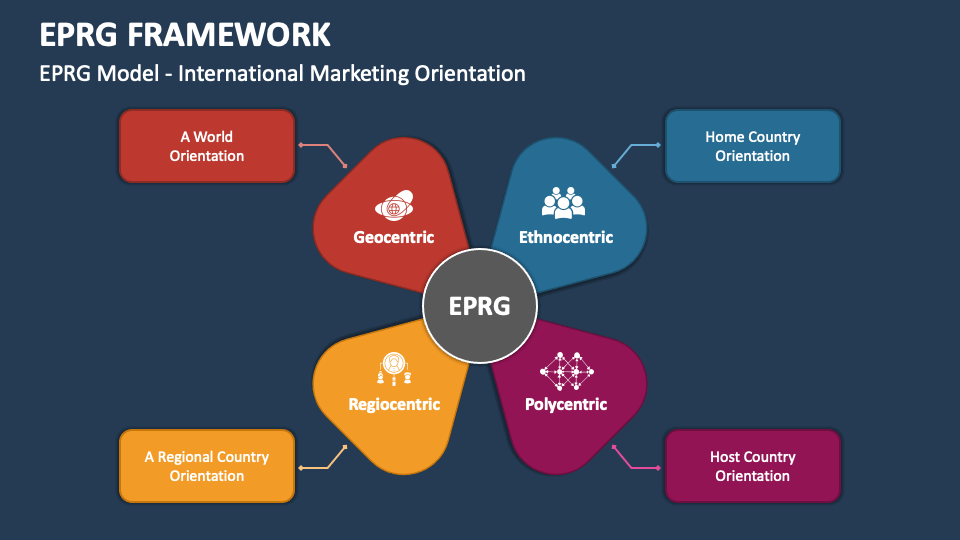EPRG Framework Detailed Explanation¶
The EPRG framework, conceptualized by Wind, Douglas, and Perlmutter, offers a nuanced perspective on how company management views and approaches international markets. This framework is instrumental in categorizing management attitudes into four distinct orientations—Ethnocentric, Polycentric, Regiocentric, and Geocentric—each representing a unique strategy for engaging with global markets.

Ethnocentric Orientation¶
An Ethnocentric Orientation is characterized by a firm belief in the superiority of one's home country's practices over foreign methods. Companies with this outlook assume that strategies and products successful in their domestic market will automatically translate to success in international markets, without any modifications. This perspective often leads to a preference for appointing executives from the home country, driven by the belief that they are best suited to understand and implement the company's vision worldwide.
Detailed Examples
-
Nissan's Misstep in the US Market: Nissan faced challenges when exporting automobiles designed for Japan's milder winters to the USA, where winter conditions are far more severe. The company's oversight was assuming that American consumers would adopt the Japanese practice of covering their cars with blankets to aid in starting during cold weather. This assumption led to difficulties in the American market, highlighting the pitfalls of an ethnocentric approach.
-
Walt Disney's Cultural Clash in France: Walt Disney's expansion into France with Disneyland Paris was initially met with resistance due to its ethnocentric approach. The company replicated its US theme park model, including a ban on alcohol, which clashed with French cultural norms where wine is commonly consumed with meals. Additionally, the park was criticized as an emblem of American cultural imperialism, further exacerbated by political tensions between the US and France. These challenges underscored the limitations of applying a one-size-fits-all strategy across diverse cultural landscapes.
Polycentric Orientation¶
Companies adopting a Polycentric Orientation recognize and respect the diversity of international markets. This approach is grounded in the belief that each country has its unique cultural, economic, and market conditions that require customized strategies. Subsidiaries in different countries are granted autonomy to develop their marketing and operational plans, often led by local executives who are presumed to have a better understanding of the local market dynamics.
Detailed Examples
-
McDonald’s Global Menu Strategy: McDonald's epitomizes the polycentric approach by tailoring its menu to align with local tastes and cultural preferences. In India, where a significant portion of the population is vegetarian, McDonald's introduced vegetarian menu items, a stark contrast to its beef-centric offerings in the United States. Similarly, in European countries like France, McDonald's caters to local palate preferences by including wine as a beverage option.
-
Google's Doodle Diversity: Google demonstrates its polycentric orientation through its daily Google Doodle variations, which celebrate local heroes, events, and cultural festivities unique to each country. This approach not only honors local diversity but also enhances Google's connection with users worldwide by acknowledging and celebrating their cultural heritage.
Regiocentric Orientation¶
The Regiocentric Orientation posits that countries within the same geographic region share certain similarities that can be leveraged to develop regional strategies. This approach simplifies the complexity of global operations by allowing companies to tailor their strategies to regional blocs, assuming that these blocs exhibit homogenous characteristics.
Detailed Examples
-
Coca-Cola's Regional Messaging: Coca-Cola adopts a regiocentric approach by crafting advertising and promotional messages that resonate with regional audiences, such as those in South Asia (India, Pakistan, Bangladesh), thereby acknowledging and leveraging regional similarities in consumer behavior and preferences.
-
Goodyear's Regional Market Segmentation: Goodyear International categorizes its markets into regional segments like Asia-Pacific and Europe, tailoring its product offerings and marketing strategies to the distinct characteristics of these regions. This approach allows Goodyear to efficiently manage its operations across diverse markets by recognizing regional commonalities.
Geocentric Orientation¶
The Geocentric Orientation embodies a truly global perspective, wherein companies view the entire world as a single, potential market. This orientation discards the notion of national borders as barriers and seeks to develop global strategies that leverage the best practices and ideas from around the world. Companies with a geocentric outlook strive to balance global efficiencies with local responsiveness, aiming to achieve a universal appeal while respecting local nuances.
Detailed Examples
-
KFC's Catering to Indian Tastes: KFC adapts its offerings to cater to the vegetarian preferences prevalent in India by introducing items like the 'vegetarian thali' and Chana snacker. This strategy demonstrates KFC's commitment to combining global brand strength with local market adaptation.
-
Viacom's MTV Localization: Viacom's MTV channels, including MTV India, MTV China, and MTV Korea
, showcase a geocentric orientation by branding and programming according to local cultural norms and preferences. By employing local talent and adapting content, MTV succeeds in maintaining a global brand identity while resonating with local audiences.